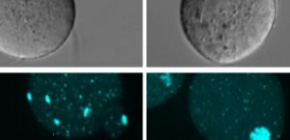
New findings and research methods leading to elucidation of fertilization mechanism
A Japanese research group has determined the crystal structure of the JUNO protein, an egg surface protein essential for fertilization. These structure-based mutational analyses elucidated a mechanism of the interaction between egg (JUNO protein) and sperm (IZUMO1) on a molecular level. These studies will provide a framework toward an understanding of the fertilization mechanism.
Fertilization is a critical process for starting new life and begins with the fusion between sperm and egg. In the steps of sperm-egg fusion, IZUMO1 on the spermatozoon and the IZUMO1 counter-receptor on the egg, JUNO, play crucial roles in the very first step, the formation of an intercellular bridge (Fig. 1), and deletion of either gene leads to the failure of gamete membrane fusion. However, the molecular mechanism by which JUNO specifically recognizes IZUMO and participates in the sperm-egg adhesion step remains to be fully understood.
A research group led by Kazuki Kato, then-graduate student, Hiroshi Nishimasu, assistant professor, and Osamu Nureki, professor, of the Graduate School of Science, The University of Tokyo, and Yuhkoh Satouh, assistant professor, and Masahito Ikawa, professor, of the Research Institute for Microbial Diseases, Osaka University, has analyzed the detailed structure and function of the JUNO protein. This group crystallized the mouse JUNO protein and, as a result of X-ray crystal structure analysis, determined the crystal structure of JUNO by molecular replacement at 2.3Åresolution (Fig. 2). They also found that JUNO and folate receptors have similar overall structures, but JUNO lacks the folate-binding pocket, thereby explaining the inability of JUNO to bind folate.
Then, by establishing a new method for complementation assay using JUNO-deleted eggs, the group examined the role of amino acid residue in fertilization. As a result of the mutational analysis, an amino acid residue of the JUNO protein, 62th Tryptophan (W62), was determined to be essential for the interaction with IZUMO1 (Fig. 3).
In this study, the crystal structure of the JUNO protein was elucidated, and the W62 residue of the JUNO protein was discovered to be essential for the interaction between sperm and egg for the first time. Furthermore, a newly established complementation system using a JUNO gene-deleted egg is expected to be a framework in future studies for the elucidation of the general mechanisms of fertilization.

Fig. 1

Fig. 2

Fig. 3
To learn more about this research, please view the full research report entitled “ Structural and functional insights into IZUMO1 recognition by JUNO in mammalian fertilization ” at this page of the Nature Communications website.
Related links

